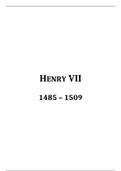HENRY VII
1485 – 1509
,HENRY VII’S BACKGROUND
Henry VII’s Character
Henry VII had not been brought up to rule.
In 1471, when Henry was fourteen, Edward IV regained power for the House of York.
In this battle, many Lancastrians died or were executed.
This forced Henry to flee to France, where he spent most of his time as a fugitive in the Duchy of Brittany.
Henry’s ability to think like a fugitive proved to be useful political training.
He was astute and clear-thinking, but he was not sentimental.
He was respected, but he was not popular.
Henry VII’s Aims
From 1485, Henry’s main purpose was to ensure that he kept his throne.
Therefore, his primary aim was to consolidate his power, which he did by a number of political actions,
combined with military success.
The Consolidation of the Tudor Dynasty
Henry dated his reign from the 21st August 1485, the day before the Battle of Bosworth, ensuring that
anyone who had fought on the Yorkist side could be deemed a traitor.
He publicly rewarded many of his key supporters (e.g. by conferring 11 knighthoods).
He arranged for his supporters to detain Elizabeth of York and the Earl of Warwick, both of which were
seen to have a greater claim to the throne than Henry.
He made key appointments to his Council and household (e.g. Sir William Stanley as Lord Chamberlain).
He arranged for his coronation to take place on the 30th October 1485, before the meeting of his first
Parliament. This was done to demonstrate that his right to the throne was hereditary, not just because
Parliament sanctioned it.
He used Parliamentary Acts of Attainder against Yorkists who had fought at Bosworth. This ensured that
their property was forfeit to the Crown, thereby increasing royal income. This was further enhanced
when Parliament granted Henry the customs revenue of tonnage and poundage for life.
Henry married Elizabeth of York in January 1486. Henry was able to exploit their marriage in royal
propaganda showing the union of the Houses of Lancaster and York (e.g. the Tudor rose combined the
red rose of Lancaster with the white rose of York).
In September 1489, Prince Arthur was born. This was an important step in securing the Tudor dynasty.
, THREATS TO HENRY’S POWER
Henry’s position was extremely insecure.
Many Yorkists were not satisfied by his marriage to Elizabeth and regarded him a usurper.
There were still several potential Yorkist claimants to the throne.
The situation became more complicated by the appearance of pretenders who were allegedly either
Edward V or his younger brother Richard.
However, what Henry feared most was the growing influence of Margaret of Burgundy.
Margaret of Burgundy was the sister of Edward IV and Richard III and the dowager duchess of Burgundy.
This meant she had access to funds which allowed her to encourage the ambitions of young Yorkist
claimants.
Viscount Lovell and the Staffords, 1486
The rebellion was led by Viscount Lovell and Humphrey Stafford.
Lovell tried to raise a rebellion in the North Riding of Yorkshire, which was Richard III’s heartland of
support.
Meanwhile, Stafford tried to raise forces against Henry in the Midlands, another area of Yorkist support.
Lovell managed to escape the king’s forces but Humphrey Stafford was captured and executed. However,
his younger brother, Thomas, was pardoned.
The rebellion was easily supressed and showed a lack of enthusiasm for a Yorkist rising in their
traditional heartlands.
Following Lovell’s rebellion, leading Yorkists realised they needed a change in strategy in order to be
successful.
They would need a figurehead who could claim to be a Yorkist prince, and they needed financial support
to generate a significant military threat.
Lambert Simnel and the Rebellion of the Earl of Lincoln
The conspiracy was put together by John de la Pole, the Earl of Lincoln, who was also a potential Yorkist
claimant.
Their figurehead was Lambert Simnel who claimed to be the Earl of Warwick, who had been imprisoned
by Henry.
Lambert Simnel was crowned King Edward in Ireland in May 1487.
In response, Henry exhibited the real Earl of Warwick in London.
The Earl of Lincoln subsequently fled from Henry VII’s court to join Lord Lovell at the court of Margaret
of Burgundy.
Together, Lovell and Lincoln persuaded Margaret to support Simnel’s claim and to pay for a force of
mercenaries to invade England.
Henry had plenty of notice that a conspiracy was being planned, so he had a large amount of time to plan
a response.
Henry reinstated the untrustworthy Earl of Northumberland, who had led a large portion of Richard III’s
forces in the Battle of Bosworth, to power in the north.
This helped to neutralise Richard’s old power base in the north.
Henry also reinforced coastal defences in East Anglia.
However, the rebels landed on the northwest coast, in Cumberland, and crossed the Pennines to gain
support in Richard III’s old heartland in the North Riding of Yorkshire.
The Yorkist gentry in the North Riding were reluctant to commit themselves wholeheartedly to the
cause, likely due to them wanting to see who was likely to win.





